OneLake
OneLake is a single, unified data lake. OneLake is provided automatically with every Microsoft Fabric tenant and is designed to be the single location for your organization’s analytics data. Every Microsoft Fabric customer tenant has exactly one OneLake.
Currently, only support for CSV, Apache Avro, Apache Parquet, and Microsoft Excel files is available.
Create a source
To connect to OneLake:
-
Navigate to Data Catalog > Sources.
-
Select Create.
-
Provide the following:
-
Name: The source name.
-
Description: A description of the source.
-
Deployment (Optional): Choose the deployment type.
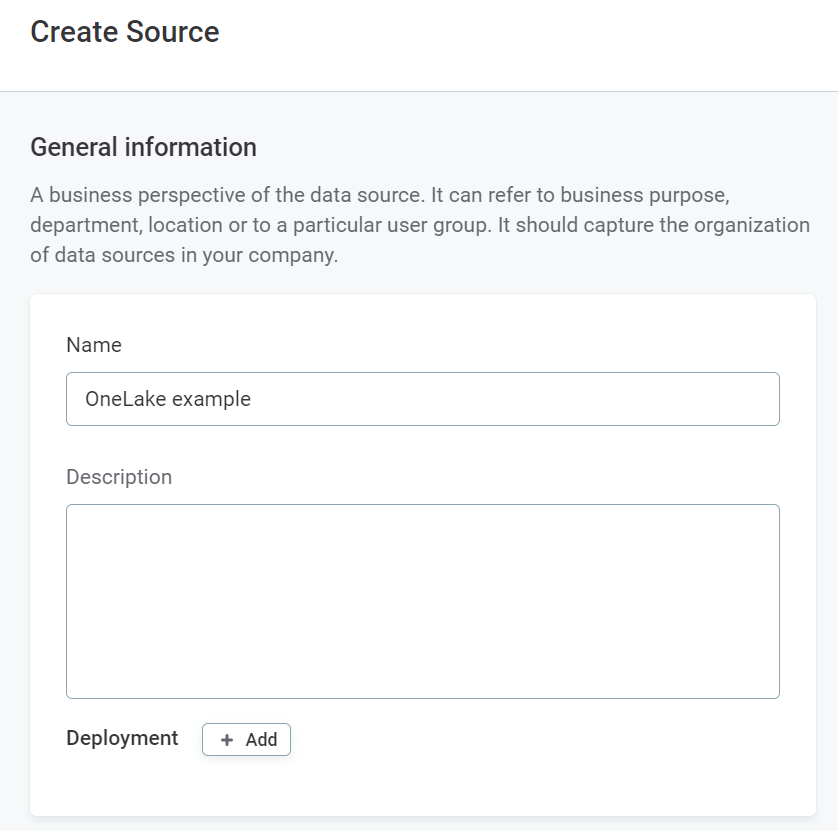
You can add new values if needed. See Lists of Values. -
Stewardship: The source owner and roles. For more information, see Stewardship.
-
| Alternatively, add a connection to an existing data source. See Connect to a Source. |
Add a connection
-
Select Add Connection.
-
In Select connection type, choose File system > OneLake.
-
Provide the following:
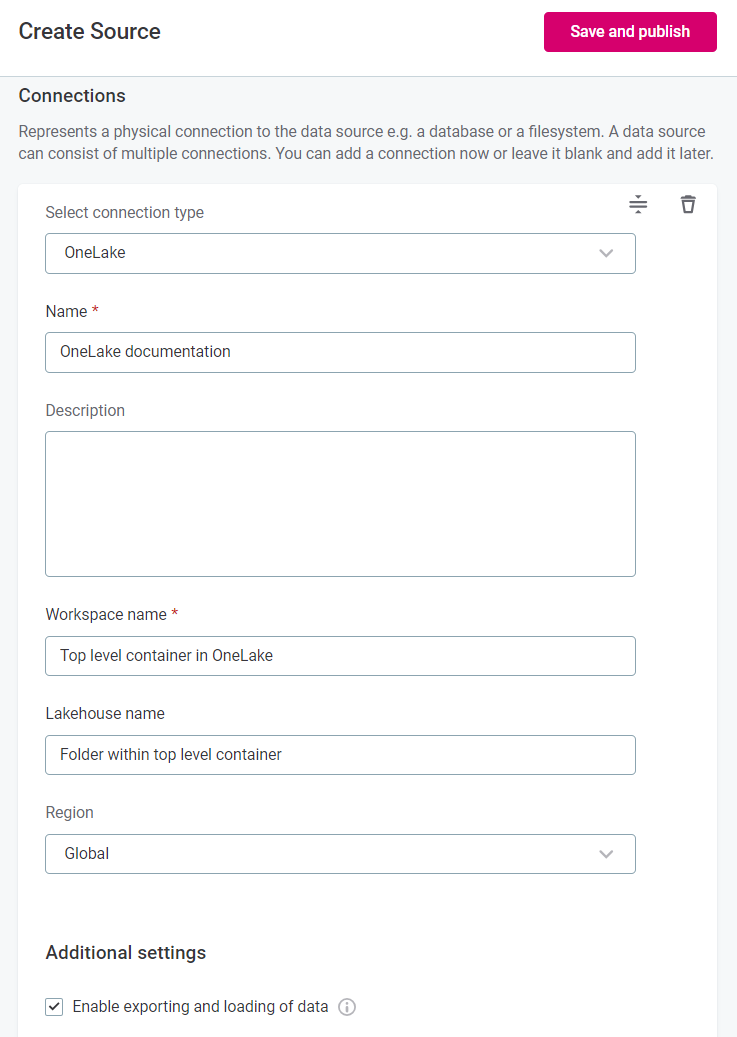
-
Name: A meaningful name for your connection. This is used to indicate the location of catalog items.
-
Description (Optional): A short description of the connection.
-
Dpe label (Optional): Assign the processing of a data source to a particular data processing engine (DPE) by entering the DPE label assigned to the engine. For more information, see DPM and DPE Configuration in DPM Admin Console.
-
Workspace name: Name of the workspace you want to connect to. Workspaces create the top folder structure in OneLake: every workspace appears as a container within your storage account.
The workspace name must not contain any special characters. To learn more about naming rules, see OneLake Access API and Naming and Referencing Containers, Blobs, and Metadata.
-
Lakehouse name: By default, you can browse the whole workspace. If you want to browse just a selected lakehouse, enter the name here.
-
Region: If you have specific needs regarding data residency, select your region from the options available; otherwise, choose
globalto use the optimal settings for your detected location.
-
-
In Additional settings, select Enable exporting and loading of Data if you want to export data from this connection and use it outside of ONE, or if you want to be able to load data from this connection to ONE Data.
If you want to export data to this source, you also need to configure write credentials. See Connection credentials.
Consider the security and privacy risks of allowing the export of data to other locations.
Add credentials
Different sets of credentials can be used for different tasks. One set of credentials must be set as default for each connection.
To determine whether you need to configure more than a single set of credentials, see Connection credentials.
-
Select Add Credentials.
-
Choose an authentication method and proceed with the corresponding step:
|
If you want to use Azure AD Managed Identity, the Data Processing Engine (DPE) must be installed in your Azure cloud subscription on a virtual machine (VM) instance, and a Managed Role must be assigned in the Microsoft Azure Portal. To fulfill this requirement, if you are using Cloud Portal, the DPE must be installed in hybrid mode. See Kubernetes-Based Hybrid DPE Deployment Guide. If you have multiple DPEs running, you might need to specify additional constraints. See Constraints Configuration. |
Azure AD Client Credential
-
Provide the following:
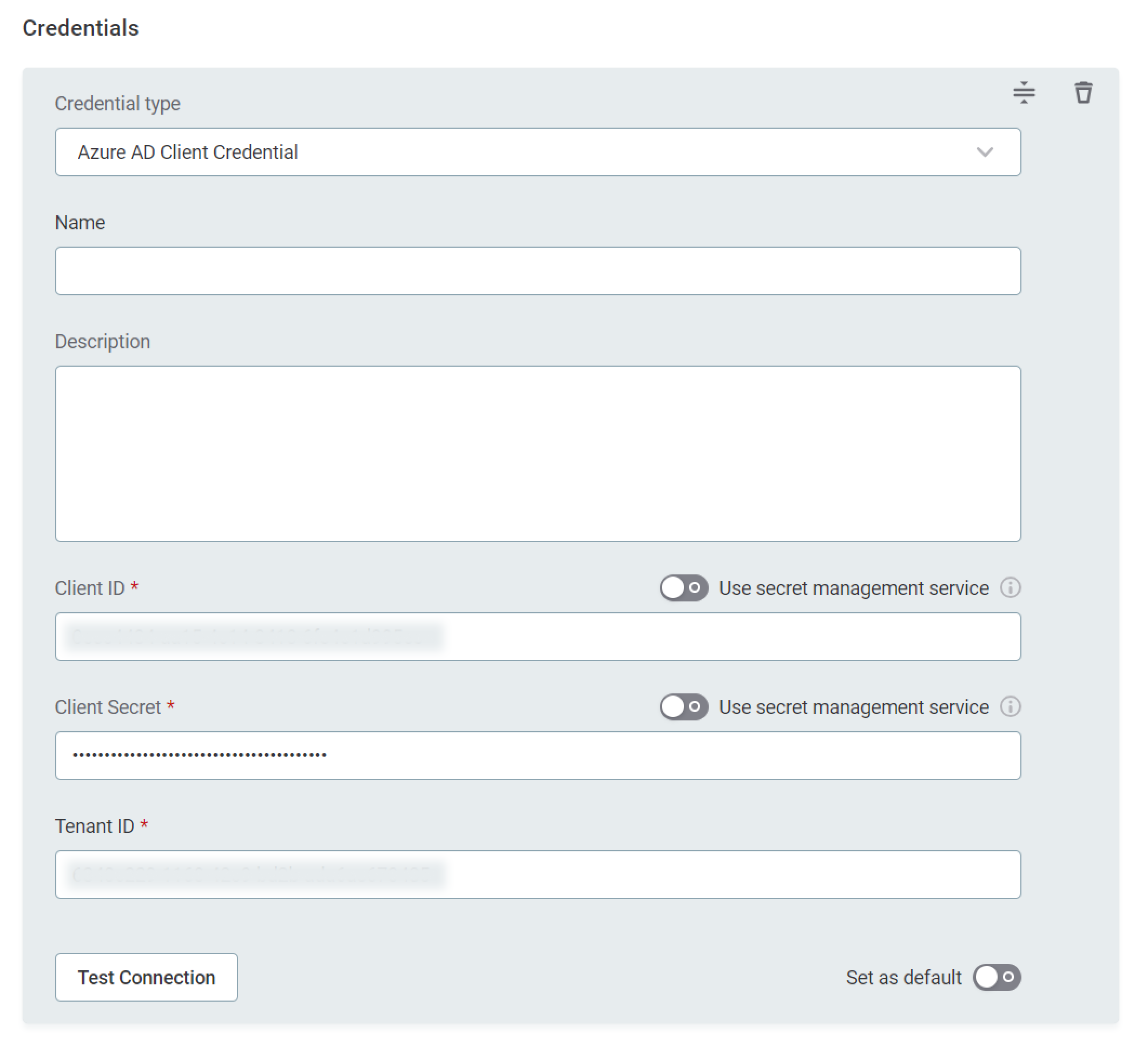
-
Name (Optional): A name for this set of credentials.
-
Description (Optional): A description for this set of credentials.
-
Client ID: The unique identifier of the application created in Azure AD. Also known as Application ID. This takes the following form (GUID):
ab12c456-789d-01ef-gg22-3h44i5jkl67m. -
Client Secret: The client secret you generated during app registration in Azure AD.
-
Tenant ID: The unique identifier of the Azure AD instance within your Azure subscription. Also known as Directory ID. This takes the following form (GUID):
ab12c456-789d-01ef-gg22-3h44i5jkl67m.
-
| Enable Use secret management service if you want to retrieve the secret from a previously configured secret management service and provide instead the name the ID and secret are stored under in your key vault. If you enable Use secret management service, you also need to select the necessary vault in Select a secret management service. For more information, see Secret Management Services. |
-
If you want to use this set of credentials by default when connecting to the data source, select Set as default.
See also Connection credentials.
-
Proceed to Test the connection.
Azure AD Managed Identity
-
Provide the following:
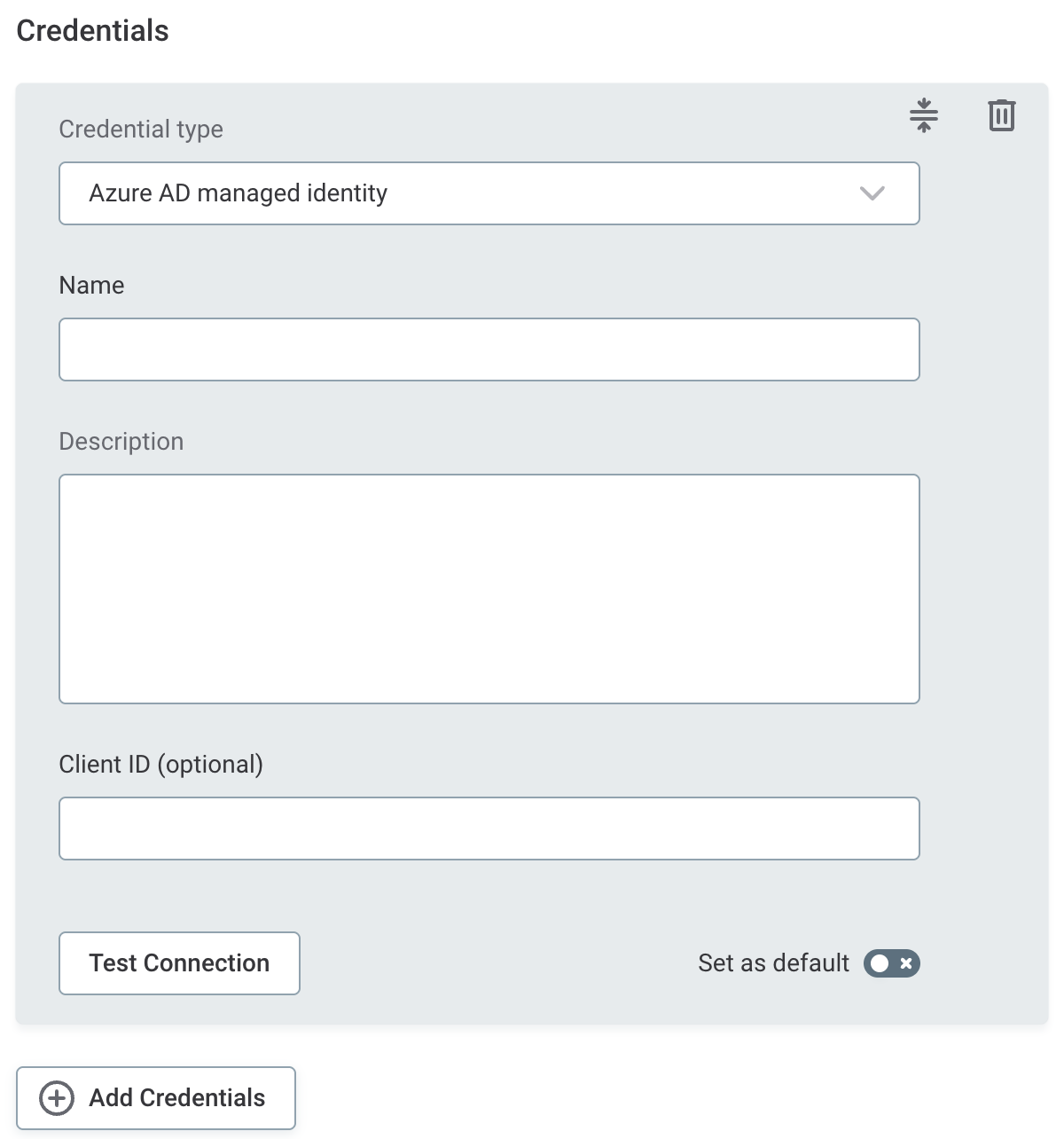
-
Name (Optional): A name for this set of credentials.
-
Description (Optional): A description for this set of credentials.
-
Client ID (Optional): The authentication key string associated with the selected managed identity.
-
-
If you want to use this set of credentials by default when connecting to the data source, select Set as default.
See also Connection credentials.
-
Proceed to Test the connection.
Test the connection
To test and verify whether the data source connection has been correctly configured, select Test Connection.
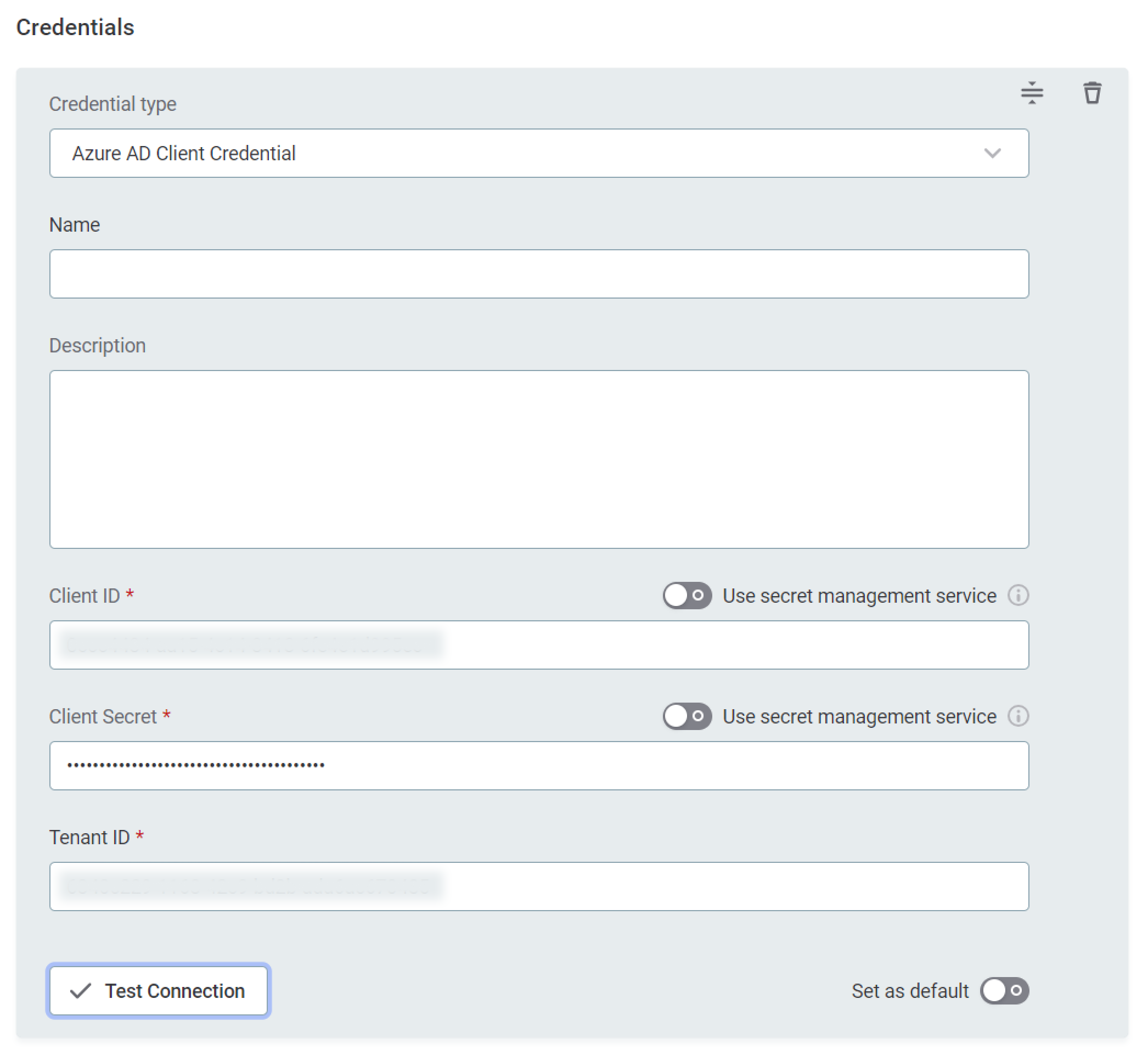
If the connection is successful, continue with the following step. Otherwise, verify that your configuration is correct and that the data source is running.
Save and publish
Once you have configured your connection, save and publish your changes. If you provided all the required information, the connection is now available for other users in the application.
In case your configuration is missing any required fields, you can view a list of detected errors instead. Review your configuration and resolve the issues before continuing.
Next steps
You can now browse and profile assets from your OneLake connection.
In Knowledge Catalog > Sources, find and open the source you just configured. Switch to the Connections tab and select Document. Alternatively, opt for Import or Discover documentation flow.
Or, to import or profile only some assets, select Browse on the Connections tab. Choose the assets you want to analyze and then the appropriate profiling option.
Was this page useful?
